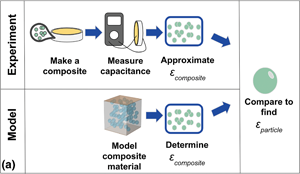Article contents
Determining the dielectric constant of injection-molded polymer-matrix nanocomposites filled with barium titanate
Published online by Cambridge University Press: 14 September 2020
Abstract

Barium titanate (BTO) is a ferroelectric perovskite with potential in energy storage applications. Previous research suggests that BTO dielectric constant increases as nanoparticle diameter decreases. This report recounts an investigation of this relationship. Injection-molded nanocomposites of 5 vol% BTO nanoparticles incorporated in a low-density polyethylene matrix were fabricated and measured. Finite-element analysis was used to model nanocomposites of all BTO sizes and the results were compared with experimental data. Both indicated a negligible relationship between BTO diameter and dielectric constant at 5 vol%. However, a path for fabricating and testing composites of 30 vol% and higher is presented here.
- Type
- Research Letters
- Information
- Copyright
- Copyright © The Author(s), 2020, published on behalf of Materials Research Society by Cambridge University Press
References
- 5
- Cited by





